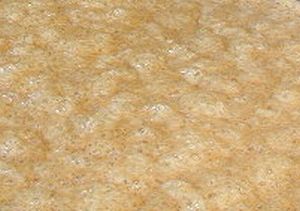Related Research Articles

Lactic acid is an organic acid. It has a molecular formula CH3CH(OH)COOH. It is white in the solid state and it is miscible with water. When in the dissolved state, it forms a colorless solution. Production includes both artificial synthesis as well as natural sources. Lactic acid is an alpha-hydroxy acid (AHA) due to the presence of a hydroxyl group adjacent to the carboxyl group. It is used as a synthetic intermediate in many organic synthesis industries and in various biochemical industries. The conjugate base of lactic acid is called lactate.

Fermentation is a metabolic process that produces chemical changes in organic substrates through the action of enzymes. In biochemistry, it is narrowly defined as the extraction of energy from carbohydrates in the absence of oxygen. In food production, it may more broadly refer to any process in which the activity of microorganisms brings about a desirable change to a foodstuff or beverage. The science of fermentation is known as zymology.

Seliwanoff’s test is a chemical test which distinguishes between aldose and ketose sugars. If the sugar contains a ketone group, it is a ketose. If a sugar contains an aldehyde group, it is an aldose. This test relies on the principle that, when heated, ketoses are more rapidly dehydrated than aldoses. It is named after Theodor Seliwanoff, the chemist that devised the test. When added to a solution containing ketoses, a red color is formed rapidly indicating a positive test. When added to a solution containing aldoses, a slower forming light pink is observed instead.
S. P. Singh, is a professor of biochemistry.

The xanthoproteic reaction is a method that can be used to detect a presence of protein soluble in a solution, using concentrated nitric acid. The test gives a positive result in amino acids carrying aromatic groups, especially in the presence of tyrosine. If the test is positive the proof is neutralized with an alkali, turning dark yellow. The yellow colour is due to xanthoproteic acid which is formed due to nitration of certain amino acids, most common examples being tyrosine and tryptophan. This chemical reaction is a qualitative test, determining the presence or absence of proteins.
Boro-glycerine is a transparent yellow, tasteless, compound of boric acid and glycerine. It is a powerful antiseptic and is used primarily in oral and dental applications. Historically, it was also used in the preservation of food.

The Sakaguchi test is a chemical test used for detecting the presence of arginine in proteins. It is named after the Japanese Food Scientist and Organic Chemist, Shoyo Sakaguchi (1900–1995) who described the test in 1925. The Sakaguchi reagent used in the test consists of 1-Naphthol and a drop of sodium hypobromite. The guanidine group in arginine reacts with the Sakaguchi reagent to form a red-coloured complex.
The Hopkins-Cole reaction, also known as the glyoxylic acid reaction, is a chemical test used for detecting the presence of tryptophan in proteins. A protein solution is mixed with Hopkins Cole reagent, which consists of glyoxylic acid. Concentrated sulfuric acid is slowly added to form two layers. A purple ring appears between the two layers if the test is positive for tryptophan. Nitrites, chlorates, nitrates and excess chlorides prevent the reaction from occurring.
The Sullivan reaction is a chemical test used for detecting the presence of cysteine or cystine in proteins. A red colour appears when a protein with cysteine or cystine is heated with sodium 1,2-naphthoquinone-4-sulfonate and sodium dithionite under alkaline conditions. This was pioneered by the American Organic and Industrial Chemist, Eugene Cornelius Sullivan (1872–1962).
The Acree-Rosenheim reaction is a chemical test used for detecting the presence of tryptophan in proteins. A protein mixture is mixed with formaldehyde. Concentrated sulfuric acid is added to form two layers. A purple ring appears between the two layers if the test is positive for tryptophan.
Nylander's test is a chemical test used for detecting the presence of reducing sugars. Glucose or fructose reduces bismuth oxynitrate to bismuth under alkaline conditions. When Nylander's reagent, which consists of bismuth nitrate, potassium sodium tartrate and potassium hydroxide, is added to a solution with reducing sugars, a black precipitate of metallic bismuth is formed.
The rapid furfural test is a chemical test used to distinguish between glucose and fructose. The rapid furfural test is similar to Molisch's test but uses concentrated hydrochloric acid instead of concentrated sulfuric acid and the solution is boiled. Dilute sugar solution is added to ethanolic 1-Naphthol and concentrated hydrochloric acid. The solution is then boiled and if a purple colour forms within thirty seconds, fructose is present. If a purple colour doesn't appear before thirty seconds, glucose is present.
Heller's test is a chemical test that shows that strong acids cause the denaturation of precipitated proteins. Concentrated nitric acid is added to a protein solution from the side of the test tube to form two layers. A white ring appears between the two layers if the test is positive. Heller's test is commonly used to test for the presence of proteins in urine. This test was discovered by the Austrian Chemist, Johann Florian Heller (1813-1871).
Gunzberg's test is a chemical test used for detecting the presence of hydrochloric acid. Gunzberg's reagent is made by dissolving two grams of phloroglucinol and one gram of vanillin in 100 millilitres of 95% ethanol. Hydrochloric acid catalyses Gunzberg's reagent to form a red complex.
Gmelin's test is a chemical test used for detecting the presence of bile pigments in urine. It is named after Leopold Gmelin, who introduced the test. Five millilitres of urine is slowly added to five millilitres of concentrated nitric acid in a test-tube. Different coloured rings between the two layers are visible if bile pigments are present as they are oxidised to various chemical products. Nitric acid is used as the oxidising agent. Blue, green and violet rings are seen if bilirubin is present. Gmelin's test is not sensitive so a positive result always indicates the presence of bile pigments but a negative result does not exclude the presence of small quantities of bile pigments.
Hay's test, also known as Hay's sulphur flower test, is a chemical test used for detecting the presence of bile salts in urine.
Carbonated soda treatment of phytobezoars is the use of carbonated soda to try to dissolve a phytobezoar. Bezoars consist of a solid and formed mass trapped in the gastrointestinal system, usually in the stomach. These can also form in other locations.
A cementicle is a small, spherical or ovoid calcified mass embedded within or attached to the cementum layer on the root surface of a tooth, or lying free within the periodontal ligament. They tend to occur in elderly individuals.
John Ebnezar is known for promoting wholistic orthopedics, a practice combining modern medical techniques with yoga for the management of Osteoarthritis of the knees and other chronic Orthopedic problems like lower back pain, neck pain, frozen shoulder etc. He was twice listed by the Guinness Book of World Records in 2010 and 2012 for the most books written by an individual in one year.
Trilok Chandra Goel worked as a Professor of Surgery in King George's Medical University, Lucknow, India between 1986 and 1999. He was re-appointed Emeritus Professor in 2015.
References
- ↑ Sood (2006). Textbook of Medical Laboratory Technology. Jaypee Brothers Publishers. p. 444. ISBN 978-81-8061-591-7.
- ↑ K. Bhattacharya & G.K. Chakraborty; Ganendrakumar Chakravarti (1978). A Handbook of Clinical Pathology. Academic Publishers. p. 205. ISBN 978-81-87504-85-6.
- ↑ Dandekar (1 January 2004). Practicals And Viva In Medical Biochemistry. Elsevier India. p. 33. ISBN 978-81-8147-025-6.
- ↑ Yadav (1 January 2003). Comprehensive Practical and Viva in Biochemistry. Jaypee Brothers Publishers. p. 84. ISBN 978-81-8061-210-7.